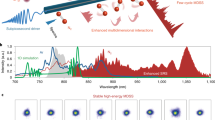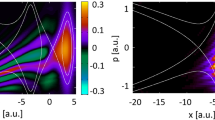Abstract
High-repetition-rate ultrafast lasers are needed for diverse applications. Harmonic modelocking, where multiple identical, equidistant pulses circulate in the cavity, reaches beyond the practical limitations of reducing the cavity length. However, it suffers from stochastic deviations that manifest as supermodes in the radio-frequency spectrum and difficulties in maintaining the same harmonic state, often coupled with trade-offs in pulse energy, duration, or noise performance. Here, we first show that deviations in the temporal positions of the pulses contribute disproportionately more to the supermodes than deviations in their amplitudes. Then, we argue that these fluctuations are analogous to those of trapped Brownian particles. This analogy reveals that supermodes are suppressed by stronger spectral filtering, which corresponds to fluid viscosity, and higher pulse energy reduces the noise, akin to lower temperature. Guided by this intuitive picture, we construct a Yb-fibre laser incorporating strong filtering and high intracavity energies by limiting nonlinear polarisation evolution to a short section of ordinary fibre. The rest of the all-fibre cavity comprises polarisation-maintaining fibre, which additionally improves environmental robustness. We report record-high supermode suppression ratios, reaching 80 dB, excellent long-term and environmental stability, and pulse energy, duration, and noise characteristics that are similar to fundamentally modelocked lasers.




Similar content being viewed by others
References
L.E. Hargrove, R.L. Fork, M.A. Pollack, Appl. Phys. Lett. 5, 4 (1964)
C. Kerse, H. Kalaycıoğlu, P. Elahi, B. Çetin, D.K. Kesim, Ö. Akçaalan, S. Yavaş, M.D. Aşık, B. Öktem, H. Hoogland, R. Holzwarth, F.Ö. Ilday, Nature 537, 84 (2016)
N. Ji, J.C. Magee, E. Betzig, Nat. Methods 5(2), 197–202 (2008). https://doi.org/10.1038/nmeth.1175
B.W. Tilma, M. Mangold, C.A. Zaugg, S.M. Link, D. Waldburger, A. Klenner, A.S. Mayer, E. Gini, M. Golling, U. Keller, Light Sci. Appl. 4, e310 (2015)
T.J. Kippenberg, A.L. Gaeta, M. Lipson, M.L. Gorodetsky, Science 361, 8083 (2018)
B. Stern, X. Ji, Y. Okawachi, A.L. Gaeta, M. Lipson, Nature 562, 401 (2018)
H.A. Haus, IEEE J. Quantum Electron. 11, 323 (1975)
F. Quinlan, S. Gee, S. Ozhara, P.J. Delfyett, IEEE Photon. Technol. Lett. 19, 1221 (2007)
F. Amrani, A. Niang, M. Salhi, A. Komarov, H. Leblond, F. Sanchez, Opt. Lett. 36, 4239 (2011)
A. Hause, H. Hartwig, M. Böhm, F. Mitschke, Phys. Rev. A 78, 063817 (2008)
R. Weill, A. Bekker, V. Smulakovsky, B. Fischer, O. Gat, Optica 3, 189 (2016)
V.A. Ribenek, D.A. Korobko, A.A. Fotiadi, J.R. Taylor, Opt. Lett. 47, 5236 (2022)
S. Zhou, D.G. Ouzounov, F.W. Wise, Opt. Lett. 31, 1041 (2006)
B. Ortaç, A. Hideur, G. Martel, M. Brunel, Appl. Phys. B 81, 507 (2005)
C. Lecaplain, P. Grelu, Opt. Express 21, 10897 (2013)
J. Wang, X. Bu, R. Wang, L. Zhang, J. Zhu, H. Teng, H. Han, Z. Wei, Appl. Opt. 53, 5088 (2014)
B. Piechal, T.M. Kardas, M. Pielach, Y. Stepanenko, Stable harmonic mode locking in all PM-Fiber Mamyshev oscillator. Conference on Lasers and Electro-optics, SW3R.4. https://doi.org/10.1364/CLEO_SI.2020.SW3R.4
A.B. Grudinin, S. Gray, J. Opt. Soc. Am. B 14, 144 (1997)
B. Ortaç, A. Hideur, M. Brunel, Opt. Lett. 29, 1995 (2004)
R. Brown, Philos. Mag. 4, 161 (1827)
A. Einstein, Ann. Phys. 322, 549 (1905)
H. Haken, H. Sauermann, C. Schmid, H.D. Vollmer, Z. Phys. 206, 369 (1967)
G. Volpe, D. Petrov, Phys. Rev. Lett 97, 210603 (2006)
V.J. Matsas, T.P. Newson, M.N. Zervas, Opt. Commun. 92, 61 (1992)
N.J. Doran, D. Wood, Opt. Lett. 13, 56 (1988)
G.P. Agrawal, Nonlinear Fiber Optics, 4th edn. (Elsevier Inc., 2004)
F.Ö. Ilday, J.R. Buckley, W.G. Clark, F.W. Wise, Phys. Rev. Lett. 92, 213902 (2004)
W.H. Renninger, A. Chong, F.W. Wise, Phys. Rev. A 82, 021805 (2010)
W.H. Renninger, A. Chong, F.W. Wise, Opt. Express 19, 22496 (2011)
B. Oktem, C. Ülgüdür, F.Ö. Ilday, Nat. Photon 4, 307 (2010)
A. Chong, J. Buckley, W. Renninger, F. Wise, Opt. Express 14, 10095 (2006)
M. Erkintalo, C. Aguergaray, A. Runge, N.G.R. Broderick, Opt. Express 20, 22669 (2012)
M. Pielach, B. Piechal, J. Szczepanek, P. Kabacinski, Y. Stepanenko, IEEE Access 8, 145087 (2020)
Ç. Şenel, R. Hamid, C. Erdoğan, M. Çelik, F.Ö. Ilday, Phys. Rev. Appl. 10, 1 (2018)
D. Mortag, D. Wandt, U. Morgner, D. Kracht, J. Neumann, Opt. Express 19, 546 (2011)
I.L. Budunoğlu, C. Ülgüdür, B. Oktem, F.Ö. Ilday, Opt. Lett. 34, 42916 (2009)
K. Gürel, P. Elahi, L. Budunoğlu, Ç. Şenel, P. Paltani, F.Ö. Ilday, Appl. Phys. Lett. 105, 011111 (2014)
P. Elahi, H. Kalaycıoğlu, Ö. Akçaalan, C. Ertek, K. Eken, F.Ö. Ilday, Opt. Lett. 43, 535 (2018)
Acknowledgements
The authors acknowledge Ghaith Makey for support in the automatisation of the data acquisition. This work received funding from the European Research Council (ERC) under the European Union’s Horizon 2020 research and innovation programme (SUPERSONIC and UniLase with grant agreements No. 966846 and No. 101055055, respectively) and TÜBİTAK (Grant agreement No. 20AG024).
Author information
Authors and Affiliations
Corresponding author
Ethics declarations
Conflict of interest
The authors declare no competing interests.
Additional information
Publisher's Note
Springer Nature remains neutral with regard to jurisdictional claims in published maps and institutional affiliations.
Contributions of energy and position deviations to the supermode suppression ratio
Contributions of energy and position deviations to the supermode suppression ratio
The radio-frequency (RF) signal is the Fourier transform of the time signal. The RF trace, at frequency f in logarithmic scale, is
Here, \({\tilde{P}} (f)\) is the Fourier transform of the photocurrent from the photodiode, C is a proportionality constant adding a vertical shift to the RF trace, \(T_{\textrm{c}}\) is the cavity round-trip time, n is a positive integer enumerating the maxima in the RF trace such that \(f_n = n / T_{\textrm{c}}\) represents all frequencies allowed by the periodicity of the cavity. Furthermore, \(\tau\) is the delay coordinate, N is the number of pulses in the cavity, \(E_j\) and \(\tau _j\) are the energy and temporal position of the \(j\)th pulse, respectively, and u describes the temporal profile of the electrical current pulse generated by the photodetector in response to an optical pulse as measured by the RF spectrum analyser. Approximating the electrical pulse shape u as a delta function leads to
With N identical pulses in the cavity (\(N\)th harmonic state), each with an energy E, and positioned equidistantly (\(\tau _j = jT_{\textrm{c}} /N\)), the Fourier transform becomes
if n/N is an integer, otherwise zero. The maxima in the RF trace at frequencies \(n/T_{\textrm{c}}\) other than integer multiples of \(N/T_{\textrm{c}}\) result from supermodes. The supermode-maxima only appear in case of deviations from the ideal pulse train. A relative (fractional) energy deviation of \(\delta _E\) in one pulse (e.g., the first pulse, \(j = 1\)) leads to
The supermode suppression ratio (SSR) (in logarithmic scale) due to the energy deviation is the ratio between Eqs. A4 and A5:
where n corresponds to the supermode for which the SSR is to be measured. In the case of a position deviation \(\delta _\tau\) in the first pulse, by linearizing with respect to \(\delta _\tau\), \(\vert {\tilde{P}} (f) \vert ^2\) becomes
The resulting SSR then is again the ratio of Eqs. A8 and A9:
Rights and permissions
Springer Nature or its licensor (e.g. a society or other partner) holds exclusive rights to this article under a publishing agreement with the author(s) or other rightsholder(s); author self-archiving of the accepted manuscript version of this article is solely governed by the terms of such publishing agreement and applicable law.
About this article
Cite this article
Laçin, M., Repgen, P., Şura, A. et al. Analogy of harmonic modelocked pulses to trapped Brownian particles improves laser performance. Appl. Phys. B 129, 46 (2023). https://doi.org/10.1007/s00340-023-07979-z
Received:
Accepted:
Published:
DOI: https://doi.org/10.1007/s00340-023-07979-z




